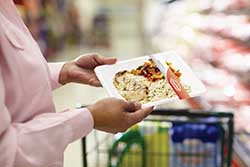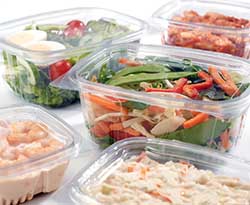A Go-To Update on Packaging for Food to Go
PACKAGING
There is no shortage of articles on the dynamics of foodservice, but we suffer from a paucity of data on the singular forms of packaging that envelop the products. So let us probe just a few to suggest that all change is not necessarily in the food alone.
 Packaging for Foods to Go
Packaging for Foods to Go
In this decade, restaurants are preparing products to order, chilling them, and packaging them for immediate delivery. Grocery stores are expanding their inventory of chilled, ready-to-eat foods. And central kitchens are preparing for delivery to retail establishments. The to go prepared dishes are generally in microwaveable trays, cups, bowls—generally thermoformed polypropylene, etc., engineered for consumer heat and eat within hours or even minutes of acquisition. Design of the containers is flat with concave base to optimize microwave radiation ingress. More recently, lidding is engineered to contain internally generated steam to complement microwave heating. And even further, for example, Cryovac’s Simple Steps® (www.sealedair.com) package vacuum packs the contents, fosters steam generation during microwave oven exposure, and automatically opens when the internal temperature reaches a “fully heated” stage to release steam pressure and permit easy stripping of the flexible lidding. The package structure was engineered to fit the broad distribution complexes of today—and perhaps tomorrow.
Foodservice Equipment
Sometimes it is difficult to distinguish between the introduction of food products and the entry of new kitchen equipment for use by chefs. Many quickservice operations engineer their back rooms to fit the specific product portfolio, while others purchase machinery and appliances on the open market. The development of single-serve coffee makers is a timely example of equipment that requires specifically packaged unit portions of dry beverage that are punctured and fed pressurized hot water to brew the desired beverage. Now that the system has been established for one family of drinks, Campbell Soup (www.campbellsoup.com) and Keurig (www.Keurig.com) have combined to “brew” soup by applying analogous technologies, which are soon to be adopted in convenience retail outlets. The added dimension is that the disposable container is to be charged with prepackaged dry vegetables to be rehydrated and impart a heterogeneous mouthfeel to the final product. The soluble dry soup powder is packaged in thermoformed polypropylene cups that fit the coffee maker. And, of course, who can but apply analogous equipment for brewing tea, lemonade, and more?
And then there is “The Answer,” an aseptic valve affixed to a premade pouch for aseptically packaged low-acid and even high-acid liquid beverages in a dispenser machine. This is intended to permit dispensing the sterile contents and reclosing the package while retaining the sterility of the contents. Already in commercial use for coffee lighteners and beverages from dispensers, the aseptic valve promises to provide prolonged shelf life for the contents of bag-in-box pouches.
Controlled Atmosphere Applications
Possibly the most noteworthy of foodservice delivery systems of this decade is the application of controlled atmosphere for fish filets. Developed by Global Fresh Foods (www.GlobalFreshFoods.com), this system was engineered specifically to acquire fish filets, package them in polyethylene film-lined corrugated fiberboard cases, palletize the cases inside a barrier film bag, alter and control the atmosphere within the bag, and transport it under carefully temperature-controlled conditions. In a daring action, temperature is controlled to just above the freezing point at about 29°F, with the oxygen level within the bag brought down to and maintained at hundreds of parts per million. The remainder of the atmosphere is carbon dioxide. Chilled shelf life of the fish in commercial practice (i.e., in shipboard container loads), is up to 45 days. Sushi chefs have declared the long shelf life raw fish as equal in quality to freshly caught and filleted. The company’s newest product is wild salmon with a chilled shelf life of 65 days, more than sufficient to move the product from Alaska to West Coast ports and even Tokyo. This system is intended to replace much more expensive air freight. Experiments are underway to be able to deliver raw pork with an 80-day chilled shelf life, chicken with 40 days, and trout with 30 days.
Larry Bell, founder of Global Fresh Foods, has stepped away from his “baby” to found a new organization, Sustainably Fresh Foods (www.sustainablyfreshfoods.com), engineering the technologies directly into shipboard containers and maintaining the required atmosphere to deliver fresh red meat and prepared foods. Might the system be applied to smaller bulk shipments of food products? There is no question that this integrative system has already made a major impact on fresh and minimally processed food delivery.
--- PAGE BREAK ---
Bulk Cheese Packaging
Until now, the process of opening and stripping 40-pound bulk cheese blocks has required knives and physical force due to the skintight package, puncture-resistant film, and heavy weight of the product itself. Curwood’s (www.bemis.com) new EZ Open Block-Tite® bulk cheese packaging transforms the opening and stripping process with easy-open, peel-away film.
The first bulk cheese package to incorporate an easy-peel feature, EZ Open Block-Tite packaging, brings together abuse-resistant Block-Tite barrier bulk film and Curwood’s EZ Peel® opening feature. With the EZ Peel feature, processors lift the flap on the block’s back seal using special grasp notches, and then peel the package open for clean, fast, complete film removal. The opening initiates a linear tear, which allows the film to pull away cleanly in a straight line, following the block shape of the cheese.
While the opening feature adds to convenience and efficiency, it also significantly improves safety. The peel-away feature eliminates personal safety hazards associated with using knives to cut and remove the film; reduces the potential for cross-contamination of cheeses via nonsterile knives; and removes the potential for film shards left on the cheese, which could then be shredded or sliced into the product.
Take-Away Packaging
Disposable take-away packaging providers have long struggled with accusations of insulting the environment. There is a seemingly endless litany from legislators attempting to eliminate expanded polystyrene to preserve the sanitary landfills and thus save the planet. Now Starbucks has introduced a portfolio of compostable beverage cups that are said to eliminate the problem for them and their consumers. Whether they are universally applicable to solid waste site compost windrows or the consumer is compelled to return their empties to a store for controlled composting is another of those intriguing questions.
Who, beyond patent litigators, can quarrel with the effectiveness of the relatively recent Heinz ketchup unit portion dispenser that doubles as a dipper or squeezer? Or the introduction of stick packs for dispensing powdered sugar or sweetener in place of bulk pouring or horizontal form/fill/seal pouches? Or spouted stand-up flexible pouches for unit portion packaging of squeezable pouches, which have finally reached the foodservice market?
 To meet demand from the growing lunchtime on-the-go food market, Europe’s LINPAC (www.linpacpackaging.com) has extended its new Freshware range for sweet and savory foods. Many of the new packs are individual or twin portion-sized to help consumers select more frugally and to help reduce food waste.
To meet demand from the growing lunchtime on-the-go food market, Europe’s LINPAC (www.linpacpackaging.com) has extended its new Freshware range for sweet and savory foods. Many of the new packs are individual or twin portion-sized to help consumers select more frugally and to help reduce food waste.
For wraps and tortillas, the food packaging company has developed Vertiwrap, a hinged box made from recycled PET, which stands vertically on the shelf to enable shoppers to see the contents clearly. Suitable for two small wraps, it has been designed to offer maximum protection to food while retaining freshness.
LINPAC’s paper bags are positioned for shops and bakeries serving freshly made sandwiches and savory snacks, providing a means to keep bread and pastry-based foods fresh and crispy. The bags are available with or without windows and come premade or on the reel for use with in-house automatic bagging machinery.
LINPAC has also designed individual and twin portion-size LeanBake packs for bakery products. Like Vertiwrap, the packs are made from crystal clear recycled PET to enhance product shelf appeal and are available in the style of a hinged box or tray and lid combination.
Envisioning Future Foodservice Packaging Trends
Foodservice is big business, which has already overtaken eating at home. Having had the opportunity to address the topic of food products and packaging for away-from-home consumption for too many years, it is my opinion that the systems were originally cheap copies of retail bulk. Today, however, the systems appear to concentrate on environmental friendliness. In reality, however, the need has been to preserve and protect in relatively unfriendly distribution channels that have focused on cost-effectiveness. Perhaps the soon to be electronically driven distribution controls will generate a new family of packaging that optimizes preservation and links more closely to the equipment, the consumer, and his/her ever-increasing selectivity.
 Aaron L. Brody, Ph.D., CFS, Contributing Editor
Aaron L. Brody, Ph.D., CFS, Contributing Editor
President and CEO, Packaging/Brody Inc., Duluth, Ga.,
and Adjunct Professor, University of Georgia
[email protected]
